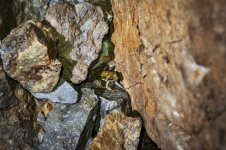PeteHall
Moderator
Reached the terminal sump in Charterhouse (England's deepest cave  ) on Saturday, to find a fully grown, healthy looking frog sitting by the sump pool!
) on Saturday, to find a fully grown, healthy looking frog sitting by the sump pool! 
I can't imagine that it would have survived getting washed through the whole cave, even if the stream flowed that way (which it doesn't), so I can only assume that it grew there.
How on Earth did it get enough to eat to grow to that size, and how long must it have been there?
I can't imagine that it would have survived getting washed through the whole cave, even if the stream flowed that way (which it doesn't), so I can only assume that it grew there.
How on Earth did it get enough to eat to grow to that size, and how long must it have been there?



